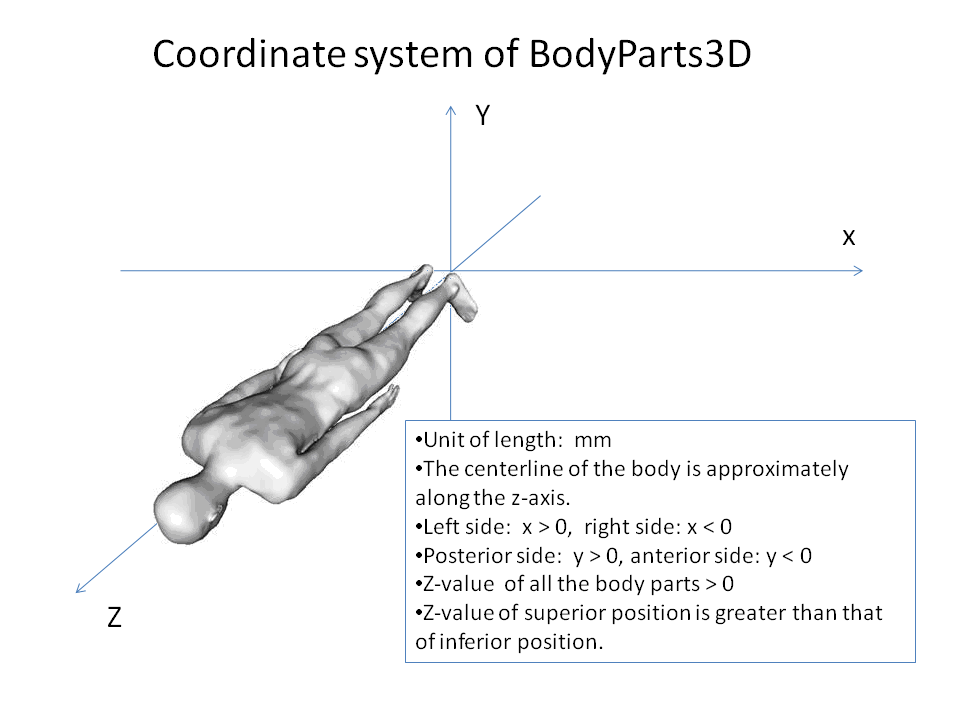BodyParts3D Release Note (Release 2.0, 2010/4/28)
1. What’s new
The followings have been updated since the previous version (Rel. 1.0, 2009/2/9)
- Thoracic organs and skeletal bones have been refined based on the following anatomy textbooks and charts.
- Gray's Anatomy for Students (1st Ed.)[1]: Chapter 3 "Thorax"
- Prometheus: LernAtlas der Anatomie, Hals und Innere Organe [2]
- Clinically oriented anatomy [3]
- 3D-CG de manabu haikuiki-kaibou kihonkei kara kakushu hennimade DVD-ROM
[Sectional anatomy of lung by using 3D-CG, from basic types to variations][4]
- Most skeletal muscles have been newly created.
The following anatomy textbooks were referred to for the origin and the insertion of each muscle:
- Taschenatlas Der Anatomie fur Studium und Praxis (3rd Ed.)[5]
- Atlas of human anatomy (4th Ed.)[6]
- Grant's atlas of anatomy (11th Ed.)[7]
The models have been refined and created in detail.
2. Cautions in use
There are some incomplete parts since BodyParts3D is being improved.
- Organs might be spatially overlapped or unnecessary spaces might exist.
- Tube-shaped organs like vessels and trachea are made as solids.
- At this time, BodyParts3D does not contain all the anatomical terms/concepts
in Terminologia anatomica (TA)[8] or anatomy ontologies like Foundational Model of Anatomy (FMA)[9],
because it contains only organs that already have been created as 3D-models.
- There is an inclusion (i.e. part-of) relation between organs denoted by anatomical terms.
For examples, the nervous system is composed of the central and the peripheral nervous system.
There are two relationships, "central nervous system part-of nervous system" and
"peripheral nervous system part-of nervous system".
In BodyParts3D, a compound body part is defined as a sum of its components,
based on these relationships defined in FMA[9] or TA[8].
The number of defined organs in BodyParts3D is smaller than that in FMA[9] or TA[8].
We omitted some of the relationships without losing consistency.
3. The number of body parts (organs) and the construction phases
| English | # of parts |
|---|
| nervous system | 58 |
| sense organ system | 4 |
| cardiovascular system | 75 |
| respiratory system | 11 |
| alimentary system | 54 |
| endocrine system | 5 |
| lymphoid system | 5 |
| urinary system | 9 |
| genital system | 18 |
| skeletal system | 270 |
| muscular system | 768 |
| articular system | 30 |
| integumentary system | 6 |
| others | 1 |
| total | 1,314 |
All the release 2.0 parts are in phase 2 of BodyParts3D construction.
Definition of BodyParts3D construction phase
- Phase 1: 3D organ models made by further segmenting an existing model
(Numerical human model database
developed by NICT[10])
- Phase 2: 3D models created almost from scratch by medical artists based on mock-ups, atlases and anatomy textbooks
- Phase 3: Phase 2 data inspected and assured by medical doctors
4. Coordinate system of BodyParts3D

5. Release history
- Release 2.0: 2010/4/28
- Release 1.0: 2009/2/9
6. References
1. Richard L. Drake, Wayne Vog, Adam W.M. Mitchell: Gray's Anatomy for Students: Churchill Livingstone; 2004.
2. Sch¨unke M, Schumacher U, Voll M, Wesker K, Schulte E: Prometheus: LernAtlas der Anatomie, Hals und Innere Organe: Thieme Georg Verlag; 2005.
3. Moore KL: Clinically oriented anatomy. Baltimore, MD: Baltimore, MD : Lippincott Williams & Wilkins; 2006.
4. Arai T: 3D-CG de manabu haikuiki-kaibou kihonkei kara kakushu hennimade DVD-ROM [Sectional anatomy of lung learned by using 3D-CG, from basic types to variations]. In.: Atoms; 2008.
5. Kahle W: Taschenatlas Der Anatomie fur Studium und Praxis, In 3 Banden (3 Volume Set in Japanese): Georg Thieme Verlag Stuttgart; 1986.
6. Netter FH: Atlas of human anatomy. Philadelphia, Pa: Philadelphia, Pa : Saunders/Elsevier; 2006.
7. Agur AMR, Dalley II AF: Grant's atlas of anatomy. Philadelphia, Pa.: Philadelphia, Pa. : Lippincott Williams & Wilkins; 2005.
8. Kahle W, Leonhardt H, Platzer W: Terminologia anatomica : international anatomical terminology / FCAT, Federative Committee on Anatomical Terminology. Stuttgart ; New York: Stuttgart ; New York : Thieme; 1998.
9. Rosse C, Mejino JLV: A reference ontology for biomedical informatics: the Foundational Model of Anatomy. Journal of Biomedical Informatics 2003, 36(6):478-500.
10. Nagaoka T, Watanabe S: Postured voxel-based human models for electromagnetic dosimetry. Physics in Medicine and Biology 2008, 53(24):7047-7061.
